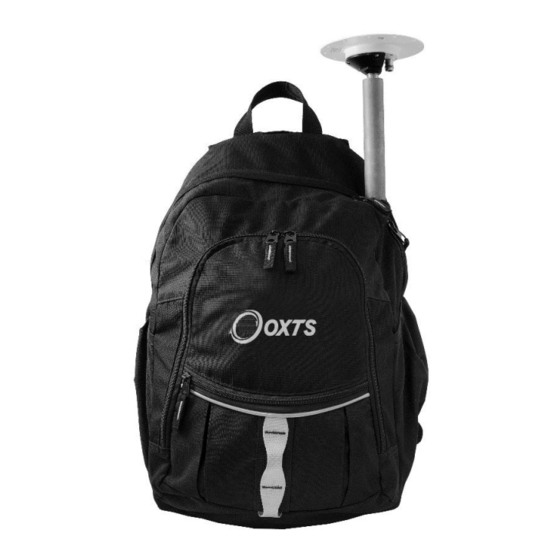
Table of Contents
Advertisement
Quick Links
Advertisement
Table of Contents

Summary of Contents for OXTS RT-Backpack
- Page 1 User Manual RT-Backpack Vehicle-to-pedestrian tracking...
-
Page 2: Legal Notices
Contact details Oxford Technical Solutions Limited Park Farm Business Centre Middleton Stoney Oxfordshire OX25 4AL United Kingdom Tel: +44 (0) 1869 814 253 Fax: +44 (0) 1869 251 764 Web: https://www.oxts.com Email: support@oxts.com Oxford Technical Solutions Ltd www.oxts.com Page 1 of 14... -
Page 3: Warranty
Technical Solutions Limited with respect to the products herein. Environmental protection Waste electrical products should not be disposed of with household waste. Please recycle where facilities exist. Check with your Local Authority or OxTS representative for recycling advice. Oxford Technical Solutions Ltd www.oxts.com... -
Page 4: Table Of Contents
Environmental protection ........................2 System overview ............................. 4 Scope of delivery ............................. 4 Specification ............................5 Assembly instructions ..........................5 Configuring the RT-Backpack ......................... 6 NAVconfig settings ..........................6 NAVconfig Options ......................... 11 RT-Range Settings ..........................11 Initialisation and warm-up ........................12 Charging the battery .......................... -
Page 5: System Overview
RT-Range target. RT-Range hunters do not differentiate between data received from target RT-Ranges or RT-Backpacks and treat both as mobile targets. For that reason, only information unique to the RT-Backpack is covered in this manual. All other relevant information can be found in the RT-Range manual. -
Page 6: Specification
Mass (kg) Assembly instructions Assembly of the RT-Backpack is not complicated but requires care to avoid damaging components. Please follow this process while referring to the diagram in Figure 1: 1. Use 3 mm hex driver to screw the three M4 × 8 mm cap head screws into the RT (leaving the top left hole free. -
Page 7: Configuring The Rt-Backpack
Base-to-Antenna Extension Pole fixed to the boss on the frame front plate. The RT-XLAN can then be height adjusted for maximum performance. 8. The RT-Backpack is turned on using the toggle switch mounted near the top of the RT sensor. NB: this switch is located under the charging point [3]. - Page 8 Figure 2. NAVconfig Step 1 - Product Selection A predefined setting for the RT-Backpack is included with NAVconfig. This is normally located at C:\Program Files (x86)\OxTS\RT-Range\RT-Back. Use the Read Settings from a Folder option to locate it. See Figure 3.
- Page 9 5). It is important to re-check the “Above” measurement as the antenna pole may be set to a different height (z-axis) to the one used in the settings file. Figure 5. NAVconfig Step 4 - Primary Antenna The RT-Backpack does not use dual antennas, so make sure that option is disabled (Figure 6). Oxford Technical Solutions Ltd www.oxts.com...
- Page 10 Figure 6. NAVconfig Step 5 - Secondary Antenna The advanced slip option (Figure 7) is not applicable to the RT-Backpack. Ensure it is disabled. Figure 7. NAVconfig Step 6 - Advanced Slip Several settings should be checked on the options page (Figure 8). Most importantly, Displace Output should be disabled.
- Page 11 It is not necessary to save a copy of any settings (Figure 10) as they can be read from the device using NAVconfig. Several files are created when saving settings, so it is best to create a new folder for each set. Oxford Technical Solutions Ltd www.oxts.com Page 10 of 14...
-
Page 12: Navconfig Options
Figure 10. NAVconfig Step 9 - Save/Finish NAVconfig Options Many of the options available in step 7 of NAVconfig do not apply when configuring an RT-Backpack. Most default options are suitable with the exception of heading lock, which should be disabled. Only the settings listed here should be reviewed. -
Page 13: Initialisation And Warm-Up
Figure 11. Operating the RT-Backpack It is important not to spin too quickly when wearing the RT-Backpack as this can saturate the gyros. The RT sensor is designed to work on vehicles, boats and aircraft. Humans can spin much faster and therefore exceed the operating thresholds of the sensors. -
Page 14: Configuration
RT-XLAN units from another country. It is possible to change the configuration in the field, but it is necessary to contact OxTS support for information on how to do this. If any configuration is changed then make sure the stickers on the outside of the RT-XLAN are changed to reflect the configuration changes made. -
Page 15: Checking The Communication Link
- as shown in Table 4. Revision history Table 5. Revision history Revision Comments 130208 Initial version. 141027 Revised for RT-XLAN changes 180222 WEEE update 210303 Updated throughout. Oxford Technical Solutions Ltd www.oxts.com Page 14 of 14... - Page 16 Oxford Technical Solutions Ltd...



Need help?
Do you have a question about the RT-Backpack and is the answer not in the manual?
Questions and answers